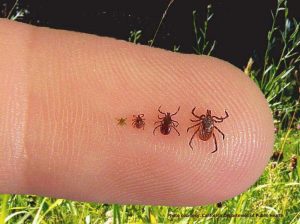Mud season—and tick season—are in full swing this year in New England!
As you get out this summer season to enjoy nature, whether you’re birding or hiking or just enjoying the sunshine, we want to encourage you to always take precautions beforehand and to do a thorough tick-check after being outside.

Carriers of diseases like Babesiosis, Anaplasmosis, Powassan encephalitis, and of course, Lyme disease, ticks are expected to thrive this year due to this spring’s wet weather and our warming climate. A study published last fall found that “assuming a 2°C (or 3.6°F) increase in annual average temperature, the number of Lyme disease cases in the United States will increase by over 20% in the coming decades.”
According to Trevor Lloyd-Evans, Director for Manomet’s Landbird Conservation Program, “At Manomet headquarters in Plymouth, our field people in the banding lab find 0.5% Permethrin spray on clothes pretty effective. Plus, wearing socks over the outside of your pants helps to keep the ticks from climbing up from the grass. Finally, some people choose to use DEET of at least 20% or more on their skin as a final layer of protection.” There are many other natural alternatives, descriptions of how to treat clothing, etc., but ALWAYS FOLLOW MANUFACTUERS INSTRUCTIONS. Whatever precautions you take this year, please stay safe!
For more information about ticks, tick-borne illnesses, and prevention, check some of these websites:





 Back to all
Back to all
